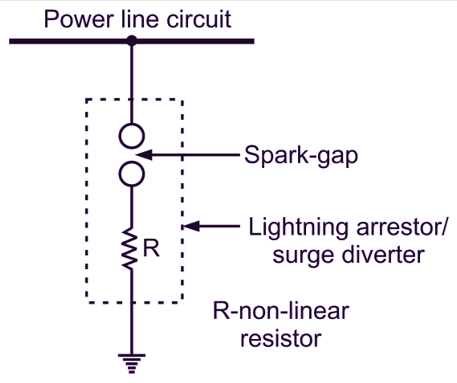Earthing screens and ground wires are suggested for protection against direct lightning strokes but they are unable to protect the equipment against travelling waves. The lightning arresters or surge diverters take care of the terminal equipments against such surges.
Function of Lightning Arrester
The function of the lightning arrester or surge diverter is to conduct the high voltage, surges on the power system to the ground, thus discharging the impulse surge to earth and to dissipate energy in the form of heat.

(a) Lightning arrester location

(b) V-I characteristic of non-linear resistor
Fig. 1: Lightning Arrester
Schematic Representation and Functioning of Arrester
Basically, the arrester has a spark-gap and to its series a non-linear resistor. (Property of non-linear resistance is that its resistance decreases as the voltage or current increases and vice-versa). One end of arrester is connected to the equipment terminal and the other is perfectly earthed.
The spark gap can be set as per the system voltage. Its length is so selected that arc is not produced due to normal system voltage but due to an abnormal high voltage produces a spark (arc) in the spark gap. The arc is formed due to breaking of insulation of air across the gap due to high surge voltage.
Working of Lightning Arrester
Step-1: No current jumps in the spark-gap when system voltage is having its normal value and equipment is working
Step-2: When the line voltage increases due to surges, this high voltage breaks the gap and an arc is produced (current jumps through the gap and passes through resistance R to ground). The arc finds the low resistance path to ground and the surge is not sent back to the line.
Step-3: As the gap sparks over due to over-voltage. Since, the property of non-linear resistance is to offer high resistance to high voltage it prevents the effect of short-circuit.
Step-4: After the surge is over, the resistor offers high resistance to make the gap non-conducting.
Design of Lightning Arrester
The design should be such that
- When the surge is over, the arc should go out immediately otherwise the current through gap and resistant will be maintained to flow destroying gap and resistor.
- During the surge current the voltage drop i.e. Surge current (I) x Resistance should not exceed the breakdown strength of insulation of the equipment to be protected against such surges.
Types of Lightning Arresters
In all types of arresters the mechanism is to provide a low resistance path for the surge currents to the ground so that the high voltage produced will not affect the equipment and its insulation remain intact. There are so many types depending upon.
- Equipment to be protected.
- Chemicals used.
- Type of gap produced.
- Discs used.
The main types of lightning arresters are
- Rod gap arrester
- Multigap arrester
- Thyrite disc-valve type arrester
- Expulsion type arrester
- Horn-gap arrester